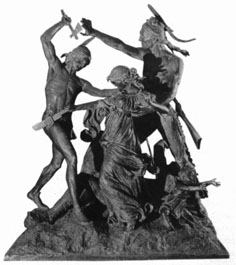|

 |
Monuments to a Lost Nationby Theodore J. Karamanski |
<Reprinted from Chicago History, Spring 2004>
Public art such as the "Fort Dearborn Massacre" and "The Alarm" played a major role in transforming the very real image of the "vanishing Indian" of the turn of the century into an enduring symbol of regional identity. But twodimensional art also had a resounding effect. In 1907, the Chicago Tribune published a pair of sketches titled "Injun Summer." These newspaper cartoons also distorted the realities of the Native American experience to tell a story that became an evocative contribution to public memory and resonated among Midwesterners for generations.
The resulting cartoon consisted of two sketches. The first depicted an old man and a young boy burning a pile of dead leaves beside a harvested field enclosed by a rail fence. In the second sketch, the stacked shocks of corn are transformed by the harvest moon into a village of tepees and the smoke of the smoldering leaves into the forms of dancing Indians. A folksy narrative accompanied the sketches ("Yep, sonny, this is sure enough Injun summer. Don't know what that is, I reckon, do you?") as the old timer explains to the young boy the meaning of the term "Indian summer": the last warm days of a Midwestern October, when the leaves turn bright red and one by one float down from their trees and the ghosts of the long departed Indians return to their old campgrounds. There is nothing to fear from this fleeting return, as the oldtimer assures the boy: "Don't be skeered hain't none around here now, leastways no live ones. They been gone this many a year." The tone of the piece is wistful, not identifying the Indians with a living dynamic culture but imaginatively rooting them in the landscape, similar to the trees, hills, and streams. Click here to view McCutcheon's "Injun Summer" and make your own decisions about it.
Forward to the next page of this essay Back to the previous page Back to Online Essays |
| |
Department
of Anthropology |
copyright © 2002
University of Illinois, All rights reserved. |

